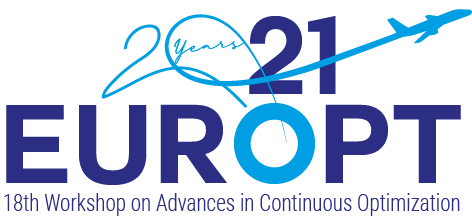FA-01: Mathematical Analysis of Optimization Methods I
Stream: Mathematical Analysis of Optimization Methods
Room: Fermat
Chair(s):
David Müller
Decompositions and projections with respect to some classes of non-symmetric cones
Jein-Shan Chen
In this talk, we focus on issues of decompositions and projections w.r.t. some classes of non-symmetric cones. These concepts and the obtained results pave a way to deal with non-symmetric cone optimization.
Strong duality, boundedness and a theorem of the alternatives in conic optimization
Akshay Gupte
Besides strict feasibility, there are other sufficient conditions for strong duality in conic optimization that are somewhat less well-known, these being a closedness condition and boundedness of feasible region inside a pointed cone. We generalize the closedness condition and show that the other two follow as a consequence of it. We also give an alternate proof for the result that if one problem is strictly feasible then it has finite optimum if and only if the other problem is feasible. Finally, we also give a theorem of the alternative that generalizes what is known for proper cones.
Properties of Generalized Oriented Distance Function and its Applications to Set Optimization Problems
Pradeep Kumar Sharma
In this talk, we discuss several interesting properties of generalized oriented distance function with respect to co-radiant sets and free disposal sets, which are more general than a cone. In particular, we deal with some special properties, like, translativity, sub-additivity and monotonicity properties using co-radiant sets so that this function can be used as a coherent measure of investment in financial mathematics. As an application, we study some optimality conditions for quasi-minimal solutions for set optimization problems.
Discrete choice prox-functions on the simplex
David Müller
We derive new prox-functions on the simplex from additive random utility models of discrete choice. They are convex conjugates of the corresponding surplus functions. In particular, we explicitly derive the convexity parameter of discrete choice prox-functions associated with generalized extreme value models and specifically with generalized nested logit models. Incorporated into subgradient schemes, discrete choice prox-functions lead to natural probabilistic interpretations of the iteration steps. We also discuss an economic application of discrete choice prox-functions in consumer theory.
